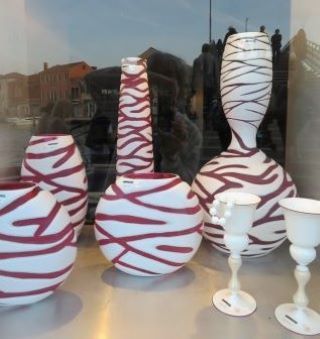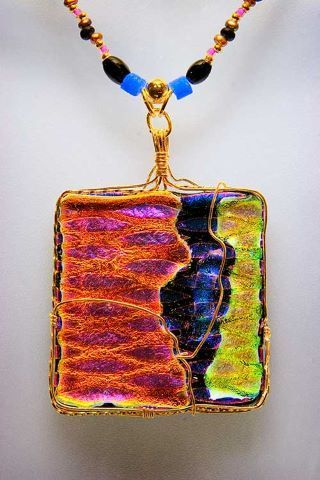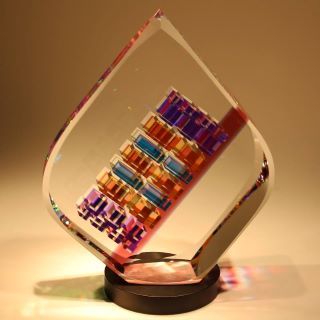Glittering, glamorous glass!
Today is all about California - we welcome a new subscriber L in California. And we are going to marvel at the unique work of a Californian man named Jack Storms, who makes glass sculptures from lead glass blocks. One of the factors that makes his works of art unique is that Jack works with lead glass blocks that are cold, or unheated, whereas almost all other glassware is formed whilst in the molten (heated liquid) state.
His pieces have found homes in numerous private collections, and two have even made it into Marvel’s TV series “Guardians of the Galaxy”.1



But before looking at Jack’s work in detail, it is perhaps worth talking a little about the different types of glass that exist. All glass has some silica in it, in varying proportions, but other added compounds make it useful for different purposes. Not all glass is created equal!
The most common commercial, household glass consists mainly of silica (which is sand) and it is usually colourless. It is a form of quartz, which, (for the chemists amongst us!), has the chemical name of silicon dioxide. It is what drinking glasses, window panes, bottles and jars are made of.2
Then there is Borosilicate glass, (pronounced boro-sili-cate), which consists of 70 – 80 percent silica, 7 – 13 percent boric oxide, and the remainder of sodium, potassium and aluminum oxides. This type of glass resists thermal shock and won’t shatter easily when subjected to changes in temperature. This type of glass is excellent as ovenware. Pyrex and Corningware products are examples of borosilicate glass.2



Venetian glass is made from silica, soda, lime and potassium melted together in a special furnace at a temperature of 1500°C to reach a liquid state. The actual formulas are closely guarded secrets handed down from generation to generation of artisans, to keep venetian glass unique and authentic.
Very thin layers of real gold or sterling silver are often added to the glass mixture (also known as gold or silver leaf), along with various minerals to give glass its vibrant colors and designs. For example, copper is used for Avventurina mineral-like sparkles, zinc is added for white color, cobalt for blue, manganese for violet, gold for red.
The resulting liquid glass mixture is then mouth-blown and/or hand-crafted by master glassmakers in a series of elaborate steps using special techniques such as Millefiori, Sommerso, Reticello, Filligrana, Bullicante, and many others.3








We have previously featured the work of Dale Chihuly, who was influenced by the Venetian masters.
He produces fascinating pieces for both indoors click here and outdoors click here.
Then we have a sub category of glass called lead glass, or crystal, which is made in the same manner as glass but with different materials. There are three primary criteria for glass to be called crystal, which were established by the European Union in 1969: a lead content in excess of 24%, a density in excess of 2.90 and a reflective index of 1.545. 4 For example, Waterford glass has a lead oxide content of over 33%, making it strong, clear and beautiful.
It has been traditional to give crystal as a gift on important occasions such as weddings, engagements and 21st birthdays as it is beautiful and more valuable than commercial glass.
Do you have any crystal wine glasses, vases or bowls in your cupboard? Waterford, Bohemia, Baccarat and Stewart are well known names you may have come across. True crystal is usually heavier than other glass items, and has a distinctive “ping” when you flick it with a fingernail! You may also see some rainbow colours in “cut” crystal, which has patterns carved into it. It is the lead content which causes light passing though it to diffract (or bend) into all the colours of the rainbow.



We must also mention one other type of glass before looking at the work of Jack Storms. It is dichroic glass, which is glass that displays two different colours by undergoing a colour change in certain lighting conditions. It is produced by stacking layers of glass and micro-layers of metals or oxides which give the glass shifting colours depending on the angle of view. For example, oxides of such metals as titanium, chromium, aluminium, zirconium, or magnesium; or silica may be used. Over 45 different colour coatings are available from the modern techniques used today. The finished glass can have as many as 30 to 50 layers of these materials, yet the thickness of the total coating is approximately 30 to 35 millionths of an inch (about 760 to 890 nm).4


There is also stained glass, particularly windows. We have just featured the work of Louis Comfort Tiffany in one of last week's 'Past Posts', which you can revisit here.
And now back to Jack Storms. The glass and crystal products we’ve mentioned above are all made with liquid, molten glass.
Jack Storms differs in that he works with cold, unheated, crystal blocks. He works with three different types of glass: optical crystal, lead crystal, and dichroic glass. Each one of Jack Storms' cold glass sculptures starts at the core. The artist then cuts, grinds, polishes and laminates the glass together, hundreds of times; until he achieves the core design he aspires to.1
He then encases the core into optical crystal and hand sculpts each piece to shape. Each one of his glass sculptures takes anywhere from six to twenty-four weeks to create and all of his artworks are original pieces of fine art. All of Jack Storms glass sculptures are designed using a cold-working lathe. There is no heat involved in the process whatsoever. 1









Jack has spent many years understanding and perfecting the processes, techniques and mathematical principles that enable him to maximise the unique properties of the crystal he works with. It is a testament to human creativity, patience and skill. I’m sure you will agree that they are mesmerizingly beautiful.
Jack explains more about the processes and time involved in his work in the video below:
If you would like to read more about the different types of glass, click here.
If you would like to read more about Jack Storms and his art, click here.
Footnotes:
With thanks to:
- Jackstorms.com
- Caithness.com
- Glassofvenice.com
- Wikipedia



